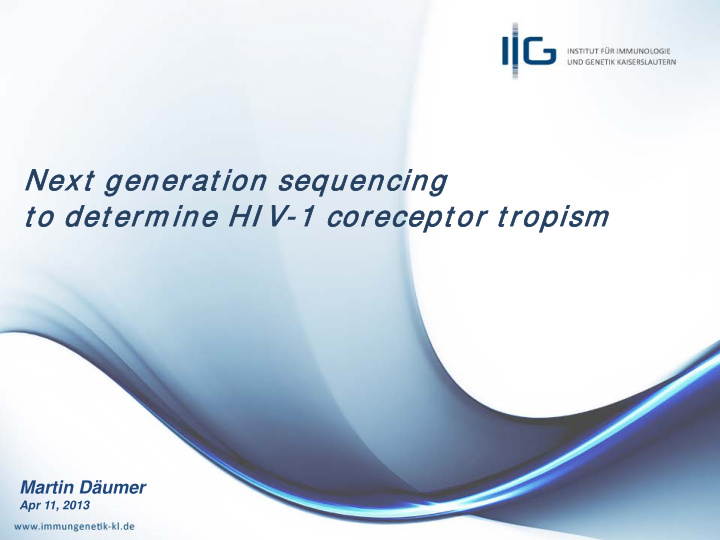



Nex ext gen ener erat ion seque uenc ncing ng t o t o det et er erm ine HI HI V-1 1 corec ecep ept or t ro ropism Martin Däumer Apr 11, 2013
Genotypic tropism testing Plasma virus RNA (first choice) Standard Sanger Sequencing Proviral DNA (Low or suppressed pVL) Plasma virus RNA (first choice) Next-Generation Sequencing Proviral DNA (Low or suppressed pVL)
Genotypic tropism testing Standard Sanger Sequencing • Availability in most HIV laboratories • Low costs • Technically simple • Low sensitivity in terms of detecting minority non-R5 variants (might be somewhat improved by triplicate parallel testing) Next-Generation Sequencing • Only few HIV laboratories ... but: things change rapidly • Higher costs • Complex workflow • Sensitivity comparable to that of phenotypic assays
Limitations of standard sequencing Reverse Transcription/ Polymerase Chain Reaction RNA extraction Blood plasma RNA cDNA M Sample 2. Nested PCR PCR products (optional) Purification (optional) Sequencing Reaction Sensitivity for m inor variants: > 2 0 % Purification Sequencer
Virologic responses of patients stratified by the percentage of non-R5 variants detected by deep sequencing at screening Of these, only 37% were detected by population sequencing MOTIVATE-1,-2, A4001029 Swenson LC et al., 2011. J Infect Dis 203:237–245
Hunting for the needle in the haystack
Technical hurdles in population sequencing Insertion Deletion
„Ultra-deep-sequencing “ Standard Sanger-sequencing ...PQIYMDDHTRE... Ultra-deep sequencing ...PQIYMDDHTRE... ...PQIYMDDHTRE... ...PQIYVDDHTRE... ...PQIYMDDHTRE... ...PQIYMDDHTRE... ...PQIYMDDHTRE...
The players
Requirements for a routine diagnostic-capable NGS system Gain in time and/or information easy sample preparation / simple workflow acceptable „turnaround times“ data volume adjusted to diagnostic need cost effectiveness „ready-to-go “ bioinformatics (does that really exist?)
eep sequencing V3 V3 deep Strategies “hybrid”-approach amplicon sequencing (amplicon/ shotgun), approach fragmentation of large amplicons Library preparation: Standard PCR fusion primers plus Library preparation: pooling, Nebulization (Roche), Fluidigm access array (4 primer Tagmentation (Nextera), approach) Fragmentation (NEB) TruSeq amplicon (4 primer approach) Sonification (Covaris)
“454” GS FLX ~ 1.000.000 „reads “ (sequences) in 10,5h ~ 500 Mio bases / run ~ 450 nts read length (amplicon)
Amplicon sequencing approach Prim er ers s label eled ed w it h MI Ds s / Roche V3
“454” GS FLX / junior Workflow Plasma cDNA Amplicon generation GS FLX Chemistry GS FLX Sequencing Sample preparation emPCR cDNA Breaking PCR Enrichment Purification Quantitation Equimolar Pooling Complex workflow
MiSeq Illumina’s benchtop sequencer easy sample preparation current specification: ~ 7-8 Gb output 2x12-15mio reads of 250 nts length each 37h run time Moderate sequencing costs
Nextera TM “tagmentation”
Library preparation using Nextera TM XT “tagmentation” • Easy library preparation • Fast - less than 20 minutes hands-on time • Only 1ng DNA per sample needed • Indices for up to 96 samples • Normalization step included
Experimental setup PRRT IN ENV whole genome
Illumina MiSeq workflow 37 3 2 x 250 nts
… putting things together „mapping“ IN ENV PRRT Reference sequences
Coverage PR/RT ENV ~7500 full V3 loops
Coverage distribution Coverages per replicate and gene, blue: PR/RT, red: ENV S1-1 S1-2 S1-3 S2-1 S2-2 S2-3 S3-1 S3-2 S3-3
geno2pheno[454]
geno2pheno [454] output
geno2pheno [454] plot prediction X4 Prediction value R5 Proportion
geno2pheno [454] read/variant distribution
MiSeq vs. 454 FLX X4 minority variants MiSeq 454
Number of sequencing errors, substitutions, deletions, and insertions Archer J et al., 2012, PLoS ONE 7: e49602. doi:10.1371/journal.pone.0049602
HIV-1 coreceptor tropism determination and virologic outcome original test patient
Viral RNA vs proviral DNA in V3 Next-Generation sequencing
Proviral DNA seen through the UDS loupe Patient F, seroconverter (IB neg), 3.8 mio. cop/ml Viral RNA Proviral DNA
Proviral DNA seen through the UDS loupe Patient F, IB complete (week 16), 76.000 cop/ml „archived diversity “ Viral RNA Proviral DNA
12/156: 7,7% FPR: 3,5 Swenson LC et al., Clin Infect Dis. 2013
Cost per sample calculation Illumina MiSeq (reagents only) 20 samples per week PRRT plus env V3 plus Integrase: 3.400 nts Coverage: 20.000 X sum: 1,4 Gb , spare capacity: 6-7 Gb Sample preparation: € 34,- /sample* Sequencing: € 50,- /sample* total € 84.- /sample (incl. of VAT) *based on Illumina‘s list prices in Germany
Patient THB* 1954 CD4+ abs Viruslast [cop/mL] 400 100000 350 10000 300 250 1000 200 100 150 100 10 50 0 1 AZT,3TC,ABC AZT,3TC,ABC,TDF diverse ART DRV/ r DRV/ r TPV/ r RAL, ETR RAL, MVC
3D l landscap ape p plot t ing of X4/ R5 p populat at ions cut off 3,5% FPR proportion
Com par arat at ive lan andscape p plot t ing of X4/ R5 populat at ions
Acknowledgements Alexander Thielen Institute for Immunology and Genetics, Bettina Spielberger Laboratory Dr. Thiele, Kaiserslautern, Kirsten Becker Germany Anna Memmer Thomas Alef Bernhard Thiele Thomas Berg, Patrick Braun, Martin Däumer, Josef Eberle, Robert Ehret, Rolf Kaiser, Klaus Korn, Claudia Kücherer, Harm Müller, Christian Noah, Martin Obermeier, Martin Stürmer, Alexander Thielen, Hauke Walter, Eva Wolf Thomas Lengauer MPI for Informatics, Saarbrücken, Germany Thank you!
Recommend
More recommend